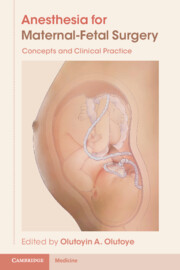Book contents
- Anesthesia for Maternal-Fetal Surgery
- Anesthesia for Maternal-Fetal Surgery
- Copyright page
- Dedication
- Contents
- Contributors
- Abbreviations
- Preface
- Acknowledgments
- Section 1
- Chapter 1 Physiology of Pregnancy
- Chapter 2 Fetal Physiology and Fetal Pain
- Chapter 3 Ethical Considerations for Maternal-Fetal Surgery
- Chapter 4 Multidisciplinary Approach to Fetal Surgery
- Chapter 5 Intrauterine Transfusion
- Section 2
- Section 3
- Index
- Endmatter
- References
Chapter 1 - Physiology of Pregnancy
from Section 1
Published online by Cambridge University Press: 19 November 2021
- Anesthesia for Maternal-Fetal Surgery
- Anesthesia for Maternal-Fetal Surgery
- Copyright page
- Dedication
- Contents
- Contributors
- Abbreviations
- Preface
- Acknowledgments
- Section 1
- Chapter 1 Physiology of Pregnancy
- Chapter 2 Fetal Physiology and Fetal Pain
- Chapter 3 Ethical Considerations for Maternal-Fetal Surgery
- Chapter 4 Multidisciplinary Approach to Fetal Surgery
- Chapter 5 Intrauterine Transfusion
- Section 2
- Section 3
- Index
- Endmatter
- References
Summary
The pregnant patient may present for fetal intervention at any time from the second trimester until near delivery. Physiological changes of pregnancy occur in every organ system in a dynamic fashion, with changes occurring to different degrees at specific periods during gestation. The maternal-fetal anesthesiologist must be familiar with expected changes. The decrease in diastolic pressure and mean arterial pressure, which nadir in the second trimester, often need to be addressed during mid-gestation fetal interventions. Other changes may need to be addressed earlier than typically expected during pregnancy. For example, the pregnant patient’s airway is characterized by mucosal edema and the need for a smaller than expected endotracheal tube. This is typically of concern at the time of delivery or non-obstetric surgery if endotracheal intubation is required. As the majority of fetal intervention procedures are performed during the mid-gestation period, the maternal-fetal anesthesiologist is often faced with managing the pregnant airway, not uncommonly in rapidly changing situations as planned sedation may be converted to general anesthesia for a variety of reasons during the procedure. All the physiologic changes of pregnancy are important to keep in mind as one approaches the clinical care of the pregnant patient.
- Type
- Chapter
- Information
- Anesthesia for Maternal-Fetal SurgeryConcepts and Clinical Practice, pp. 1 - 16Publisher: Cambridge University PressPrint publication year: 2021



